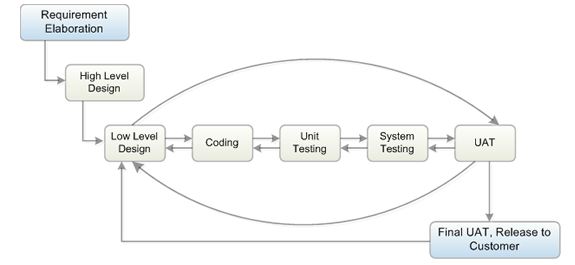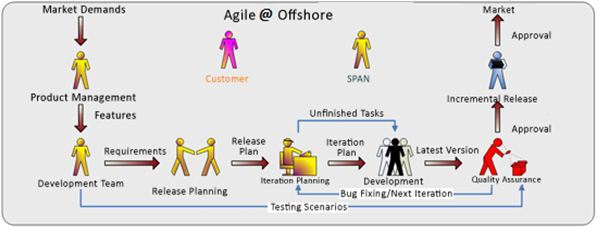
Sahasra technology and Consultancy has a wealth of experience and expertise in providing onsite/offshore services. We develop a custom-fitted strategy after meticulous evaluation of the nature of the project.This is the first step towards defining processes that ensure compliance of the deliverables within agreed norms. Sahasra Technology and Consultancy has proven expertise in gathering and defining user requirements, recommending technology solutions and designing system architecture. A strong tool based approach ensures productivity and quality at every stage.
Development Methodology
Iterative Model
Sahasra Technology and Consultancy follows Iterative model for development of product/applications that needs to be built in a phase wise manner. The features released to end users may get altered as well as new features would get implemented in feature releases based on feedback.Similarly the feedback from each stage would also modify the product features.

Requirement Elaboration Phase
During the Requirement Elaboration Phase, The team will review the current requirements document thoroughly with Client and validate the requirements. In some cases, we may need to jointly expand on the requirements or revise them to make it clear. A face-to-face meeting is needed for this phase.
High Level Design Phase
During the High Level Design Phase, the design aspects of the application will be completed. This includes:
1.Software Design Architecture
2.Logical Database Design
3.Prototype Concept of design
4.Test Strategy
Development Phase
During the Development Phase, Sahasra Technology and Consultancy proposes to develop all the features as defined in the approved SRS. The development will be based on the approved requirements from the Requirement Elaboration Phase and will use the design frozen in the High Level Design Phase. This phase also includes low-level design, User Interface, coding, unit test, integration and system testing. The Team would like to follow shorter development and testing cycles and provide working deliverables as opposed to a single long cycle and a final deliverable. The benefits of this approach are mentioned below.
Early integration will reveal any hidden surprises
It ensures that the requirements are met as expected
It provides Client with an opportunity to review the quality of the work in progress
Reduces various risks in the product lifecycle
Final UAT Phase
The Final UAT Phase will commence once all the tasks planned for the Development Phase are completed. During this phase the application will be released and the client will test the application to make sure all the features are working as defined in requirements document. Any issues reported are fixed and any enhancements provided are considered as 'Change Request'.
Agile Process
Sahasra technology and Consultancy offers Agile project methodology for suitable projects wherein the Requirements are not well-defined or evolving continuously. We have extensive experience in using this methodology
Sahasra technology and Consultancy adapted Agile Scrum as a formalized process. Since then most of the projects that are being executed for ISV's falls under either Scrum / RUP's Iterative process methodology.
Key Scrum practices are as follows:
Sprints are iterations of a fixed duration ideally 30 day Work within a sprint is fixed.
Once the scope of a Sprint is committed, no additional functionality can be added except by the development team.
All work to be done is characterized as product backlog, which includes requirements to be delivered, defect workload, as well as infrastructure and design activities.
A Scrum Master mentors and manages the self organizing and self accountable teams that are responsible for delivery of successful outcomes at each sprint.
A daily standup meeting is a primary communication method.
A heavy focus on time boxing. Sprints, standup meetings, release review meetings and the like are all completed in prescribed times.
Scrum also allows requirements, architecture and design to emerge over the course of the project.
Scrum, like RUP talks in terms of lifecycle phases In the case of Scrum, the phases are Planning, Staging, Development, and Release. Hence we find that both Agile Scrum / RUP's Iterative process methodology are the best fits.
Agile Offshore at Sahasra Technology and Consultancy is a proven methodology, which has been evolved over a period of time based on the extensive experiences gained in the past from various projects execution. Below diagrams depicts the Process Flow:


